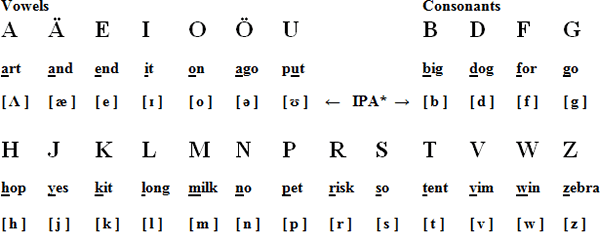Simpel-Fonetik Spellingby Allan Kiisk
Simpel-Fonetik alphabet 
New letters: Ä,ä, Ö,ö. Letters not used: C, Q, X, Y. Total: 24 letters.
* IPA is the abbreviation for International Phonetic Alphabet.
sample This is interesting: No federal government order or effort so far for ending the helter-skelter spelling. Don't beg or long for it. It's hard for the big gorilla tu start implementing spelling dogma. It wil linger, limp, loiter, swing from pillar tu post . . . As you may have noticed, this sample has only two changes: tu in place of to and wil in place of will. It illustrates that Simpel-Fonetik will not change the words that are presently spelled phonetically, based on single sound per letter.
Here is a another sample, shown first in present writing:
When you read Simpel-Fonetik words, you must pay attention to each letter. Remember: Each letter has always the same sound, the sound given in the Simpel-Fonetik alphabet, regardless what letter is next to it. And here it is re-written in Simpel-Fonetik:
Wen ju riid Simpel-Fonetik wörds, ju mast pei ätenshön tu iitsh leter. Rimember: Iitsh leter häs oolweis the seim saund, the saund given in the Simpel-Fonetik alfabet, rigardles wat leter is nekst tu it. The selection of the letters for the Simpel-Fonetik writing depends on pronunciation. In present English, the writing often does not tell you how to pronounce the word. That has resulted in different pronunciations in different regions or countries. Each pronunciation results in a different spelling in Simpel-Fonetik. Which one should be used? Some standardization procedure will be required. Simpel-Fonetik will fix the multiple pronunciations problem.
Other articles